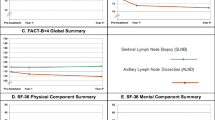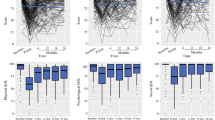Abstract
Purpose
The aim of this study was to evaluate the effects of physical therapy (PT) combined with manual lymphatic drainage (MLD) on shoulder function, pain, lymphedema, visible cords, and quality of life (QOL) in breast cancer patients with axillary web syndrome (AWS).
Methods
In this prospective, randomized trial, 41 breast cancer patients with visible and palpable cords on the arm and axilla and a numeric rating scale (NRS) pain score of >3 were randomly assigned to PT (3 times/week for 4 weeks; n = 20) and PT combined with MLD (5 times/week for 4 weeks; PTMLD; n = 21) groups. MLD was performed by a physical therapist and the patients themselves during week 1 and weeks 2–4, respectively. Arm volume, shoulder function (muscular strength; active range of motion; and disabilities of the arm, shoulder, and hand [DASH]); QOL (European Organization for Research and Treatment of Cancer Core and Breast Cancer‐Specific QOL questionnaires), and pain (NRS) were assessed at baseline and after 4 weeks of treatment.
Results
QOL including functional and symptom aspects, shoulder flexor strength, DASH, and NRS scores were significantly improved in both groups after the 4-week intervention (P < 0.05). NRS score and arm volume were significantly lower in the PTMLD group than in the PT group (P < 0.05). Lymphedema was observed in the PT (n = 6), but not PTMLD, group (P < 0.05).
Conclusions
PT improves shoulder function, pain, and QOL in breast cancer patients with AWS and combined with MLD decreases arm lymphedema.

Similar content being viewed by others
References
Leduc O, Fumiere E, Banse S, Vandervorst C, Clement A, Parijs T, Wilputte F, Maquerlot F, Ezquer Echandia M, Tinlot A, Leduc A (2014) Identification and description of the axillary web syndrome (AWS) by clinical signs, MRI and US imaging. Lymphology 47:164–176
Leidenius M, Leppanen E, Krogerus L, von Smitten K (2003) Motion restriction and axillary web syndrome after sentinel node biopsy and axillary clearance in breast cancer. Am J Surg 185:127–130
Ferreira Rezende L, Laier Franco R, Costa Gurgel MS (2005) Axillary web syndrome: practical implications. Breast J 11:531. doi:10.1111/j.1075-122X.2005.00169.x
Pappo I, Wasserman I, Stahl-Kent V, Sandbank J, Halevy A (2004) Mondor’s disease of the axilla: a rare complication of sentinel node biopsy. Breast J 10:253–255. doi:10.1111/j.1075-122X.2004.21438.x
Bergmann A, Mattos IE, Pedrosa E, Nogueira EA, Koifman R (2007) Axillary web syndrome after lymph node dissection: results for 1004 breast cancer patients. Lymphology 40:198–203
Torres Lacomba M, Mayoral Del Moral O, Coperias Zazo JL, Yuste Sanchez MJ, Ferrandez JC, Zapico Goni A (2009) Axillary web syndrome after axillary dissection in breast cancer: a prospective study. Breast Cancer Res Treat 117:625–630. doi:10.1007/s10549-009-0371-8
Bergmann A, Mendes VV, de Almeida DR, do Amaral ESB, da Costa Leite Ferreira MG, Fabro EA (2012) Incidence and risk factors for axillary web syndrome after breast cancer surgery. Breast Cancer Res Treat 131:987–992. doi:10.1007/s10549-011-1805-7
Rashtak S, Gamble GL, Gibson LE, Pittelkow MR (2012) From furuncle to axillary web syndrome: shedding light on histopathology and pathogenesis. Dermatology 224:110–114. doi:10.1159/000337210
Koehler LA, Blaes AH, Haddad TC, Hunter DW, Hirsch AT, Ludewig PM (2015) Movement, function, pain, and postoperative edema in axillary web syndrome. Phys Ther. doi:10.2522/ptj.20140377
Moskovitz AH, Anderson BO, Yeung RS, Byrd DR, Lawton TJ, Moe RE (2001) Axillary web syndrome after axillary dissection. Am J Surg 181:434–439
Giuliano AE, Haigh PI, Brennan MB, Hansen NM, Kelley MC, Ye W, Glass EC, Turner RR (2000) Prospective observational study of sentinel lymphadenectomy without further axillary dissection in patients with sentinel node-negative breast cancer. J Clin Oncol 18:2553–2559
Wei P, Zhu L, Chen K, Jia W, Hu Y, Su F (2013) Axillary web syndrome following secondary breast-conserving surgery: a case report. World J Surg Oncol 11:8. doi:10.1186/1477-7819-11-8
Katz J, Poleshuck EL, Andrus CH, Hogan LA, Jung BF, Kulick DI, Dworkin RH (2005) Risk factors for acute pain and its persistence following breast cancer surgery. Pain 119:16–25. doi:10.1016/j.pain.2005.09.008
Shamley DR, Srinanaganathan R, Weatherall R, Oskrochi R, Watson M, Ostlere S, Sugden E (2007) Changes in shoulder muscle size and activity following treatment for breast cancer. Breast Cancer Res Treat 106:19–27. doi:10.1007/s10549-006-9466-7
Karki A, Simonen R, Malkia E, Selfe J (2005) Impairments, activity limitations and participation restrictions 6 and 12 months after breast cancer operation. J Rehabil Med 37:180–188. doi:10.1080/16501970410024181
Ferrandez JC, Doyer M, Serin D, De Rauglaudre G (2007) Thromboses lymphatiques superficielles. In: Petiot S, Hérisson C, Pélissier J (eds) Cancer du sein et médecine de rééducation. Elsevier Masson, Issy-les-Moulineaux, pp 119–128
Vairo GL, Miller SJ, McBrier NM, Buckley WE (2009) Systematic review of efficacy for manual lymphatic drainage techniques in sports medicine and rehabilitation: an evidence-based practice approach. J Man Manip Ther 17:e80–e89
Goats GC (1994) Massage—the scientific basis of an ancient art: part 2. Physiological and therapeutic effects. Br J Sports Med 28:153–156
Harris R, Piller N (2003) Three case studies indicating the effectiveness of manual lymph drainage on patients with primary and secondary lymphedema using objective measuring tools. J Bodyw Mov Ther 7:213–221. doi:10.1016/s1360-8592(03)00036-6
Torres Lacomba M, Yuste Sanchez MJ, Zapico Goni A, Prieto Merino D, Mayoral del Moral O, Cerezo Tellez E, Minayo Mogollon E (2010) Effectiveness of early physiotherapy to prevent lymphoedema after surgery for breast cancer: randomised, single blinded, clinical trial. BMJ 340:b5396. doi:10.1136/bmj.b5396
Kang Y, Jang DH, Jeon JY, Lee SJ, Jeong SY, Shin DI, Kim HJ (2012) Pressure monitoring of multilayer inelastic bandaging and the effect of padding in breast cancer-related lymphedema patients. Am J Phys Med Rehabil 91:768–773. doi:10.1097/PHM.0b013e3182643c36
Taylor R, Jayasinghe UW, Koelmeyer L, Ung O, Boyages J (2006) Reliability and validity of arm volume measurements for assessment of lymphedema. Phys Ther 86:205–214
Stout Gergich NL, Pfalzer LA, McGarvey C, Springer B, Gerber LH, Soballe P (2008) Preoperative assessment enables the early diagnosis and successful treatment of lymphedema. Cancer 112:2809–2819. doi:10.1002/cncr.23494
Ford-Smith CD, Wyman JF, Elswick RK Jr, Fernandez T (2001) Reliability of stationary dynamometer muscle strength testing in community-dwelling older adults. Arch Phys Med Rehabil 82:1128–1132. doi:10.1053/apmr.2001.24291
Bohannon RW, Andrews AW (1987) Interrater reliability of hand-held dynamometry. Phys Ther 67:931–933
Norkin CC, White DJ (1995) Measurement of joint motion: a guide to goniometry. F.A. Davis, Philadelphia
Yun YH, Park YS, Lee ES, Bang SM, Heo DS, Park SY, You CH, West K (2004) Validation of the Korean version of the EORTC QLQ-C30. Qual Life Res 13:863–868
Solway S, Institute for Work & Health, American Academy of Orthopaedic Surgeons (2002) The DASH outcome measure user’s manual. Institute for work & health. American Academy of Orthopaedic Surgeons, Toronto
Beaton DE, Katz JN, Fossel AH, Wright JG, Tarasuk V, Bombardier C (2001) Measuring the whole or the parts? Validity, reliability, and responsiveness of the disabilities of the arm, shoulder and hand outcome measure in different regions of the upper extremity. J Hand Ther 14:128–146
Buchanan DR, O’Mara AM, Kelaghan JW, Minasian LM (2005) Quality-of-life assessment in the symptom management trials of the national cancer institute-supported community clinical oncology program. J Clin Oncol 23:591–598. doi:10.1200/JCO.2005.12.181
Butt Z, Wagner LI, Beaumont JL, Paice JA, Peterman AH, Shevrin D, Von Roenn JH, Carro G, Straus JL, Muir JC, Cella D (2008) Use of a single-item screening tool to detect clinically significant fatigue, pain, distress, and anorexia in ambulatory cancer practice. J Pain Symptom Manag 35:20–30. doi:10.1016/j.jpainsymman.2007.02.040
O’Toole J, Miller CL, Specht MC, Skolny MN, Jammallo LS, Horick N, Elliott K, Niemierko A, Taghian AG (2013) Cording following treatment for breast cancer. Breast Cancer Res Treat 140:105–111. doi:10.1007/s10549-013-2616-9
Kepics J (2007) Treatment of axillary web syndrome: a case report using manual techniques http://www.vodderschool.com/treatment_of_axillary_web_syndrome. Accessed 26 May 2015
Devoogdt N, Christiaens MR, Geraerts I, Truijen S, Smeets A, Leunen K, Neven P, Van Kampen M (2011) Effect of manual lymph drainage in addition to guidelines and exercise therapy on arm lymphoedema related to breast cancer: randomised controlled trial. BMJ 343:d5326. doi:10.1136/bmj.d5326
Sarri AJ, Moriguchi SM, Dias R, Peres SV, da Silva ET, Koga KH, Zucca Matthes AG, Dos Santos MJ, Da ET R, Haikel RL (2010) Physiotherapeutic stimulation: early prevention of lymphedema following axillary lymph node dissection for breast cancer treatment. Exp Ther Med 1:147–152. doi:10.3892/etm_00000024
Gartner R, Jensen MB, Kronborg L, Ewertz M, Kehlet H, Kroman N (2010) Self-reported arm-lymphedema and functional impairment after breast cancer treatment—a nationwide study of prevalence and associated factors. Breast 19:506–515. doi:10.1016/j.breast.2010.05.015
Kwan ML, Darbinian J, Schmitz KH, Citron R, Partee P, Kutner SE, Kushi LH (2010) Risk factors for lymphedema in a prospective breast cancer survivorship study: the pathways study. Arch Surg 145:1055–1063. doi:10.1001/archsurg.2010.231
Josenhans E (2007) Physiotherapeutic treatment for axillary cord formation following breast cancer surgery. Pt_Zeitschrift für Physiotherapeuten 59:868–878
Fourie WJ, Robb KA (2009) Physiotherapy management of axillary web syndrome following breast cancer treatment: discussing the use of soft tissue techniques. Physiotherapy 95:314–320. doi:10.1016/j.physio.2009.05.001
Martins da Silva RC, Rezende LF (2014) Assessment of impact of late postoperative physical functional disabilities on quality of life in breast cancer survivors. Tumori 100:87–90. doi:10.1700/1430.15821
Olufade T, Gallicchio L, MacDonald R, Helzlsouer KJ (2015) Musculoskeletal pain and health-related quality of life among breast cancer patients treated with aromatase inhibitors. Support Care Cancer 23:447–455. doi:10.1007/s00520-014-2364-3
Banasik J, Williams H, Haberman M, Blank SE, Bendel R (2011) Effect of Iyengar yoga practice on fatigue and diurnal salivary cortisol concentration in breast cancer survivors. J Am Acad Nurse Pract 23:135–142. doi:10.1111/j.1745-7599.2010.00573.x
Danhauer SC, Mihalko SL, Russell GB, Campbell CR, Felder L, Daley K, Levine EA (2009) Restorative yoga for women with breast cancer: findings from a randomized pilot study. Psychooncology 18:360–368. doi:10.1002/pon.1503
Author information
Authors and Affiliations
Corresponding authors
Ethics declarations
Conflict of interest
None of the authors has any financial support or relationship with regard to the submitted manuscript that might be construed as a conflict of interest. All authors have full control of all primary data and agree to allow the journal to review the data if requested.
Electronic supplementary material
Below is the link to the electronic supplementary material.
ESM 1
(DOCX 26 kb)
Rights and permissions
About this article
Cite this article
Cho, Y., Do, J., Jung, S. et al. Effects of a physical therapy program combined with manual lymphatic drainage on shoulder function, quality of life, lymphedema incidence, and pain in breast cancer patients with axillary web syndrome following axillary dissection. Support Care Cancer 24, 2047–2057 (2016). https://doi.org/10.1007/s00520-015-3005-1
Received:
Accepted:
Published:
Issue Date:
DOI: https://doi.org/10.1007/s00520-015-3005-1




